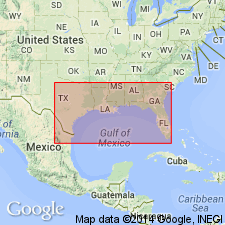
- Usage in publication:
-
- Bexar shale member
- Modifications:
-
- Original reference
- Dominant lithology:
-
- Shale
- AAPG geologic province:
-
- Ouachita folded belt
Summary:
Pg. 2333 (fig. 2), 2337 (fig. 3), 2346-2350; Gulf Coast Assoc. Geol. Soc. Trans., v. 6, p. 91 (chart), 1956. Bexar shale member of Pearsall formation. Proposed for upper of three members of Pearsall formation; includes interval between either base of Rodessa formation, Hensell sand, or Glen Rose undifferentiated, and top of Cow Creek or James limestone member. In type well, occupies interval from 3,320 to 3,340 feet and consists essentially of black calcareous shale and thin dense finely crystalliine limestone beds. Bexar is a sedimentary wedge that thickens into basin with greatest thickening southward from Llano uplift. Depositional edge of Bexar on flanks of Llano uplift is missing owing to an unconformity at base of Hensell sand so that, on outcrop, Hensell sand rests directly on Cow Creek limestone member. [Age is Early Cretaceous (Comanche).]
Type section (subsurface): depth-interval 3,320 to 3,340 ft, Ralph E. Fair, Jack Woodward, Inc., and F.B. Lafevre's Pauline Lyro Well No. 1 in the J.M. Bustillo Survey 29, Bexar Co., southern central TX. Recognized in subsurface of eastern and southern TX and northern LA.
Source: US geologic names lexicon (USGS Bull. 1200, p. 323).
For more information, please contact Nancy Stamm, Geologic Names Committee Secretary.
Asterisk (*) indicates published by U.S. Geological Survey authors.
"No current usage" (†) implies that a name has been abandoned or has fallen into disuse. Former usage and, if known, replacement name given in parentheses ( ).
Slash (/) indicates name conflicts with nomenclatural guidelines (CSN, 1933; ACSN, 1961, 1970; NACSN, 1983, 2005, 2021). May be explained within brackets ([ ]).

